| Scientists and Inventors |
 |
| Questions? Call us at 215-345-7955
or toll-free at 800-560-2545 |
|
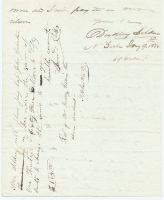 SAMUEL COLT (1814-1962)
|
| SAMUEL COLT (1814-1962) |
Pioneering firearms inventor
Pioneering firearms inventor, designer of the first practical revolver, which he patented in 1836. Manuscript letter written to Colt by Dudley Seldon offering to pay a bill on Colt's behalf, and suggesting he draw up an order on the reverse of the letter, which Colt has done. On the back of the letter is a pay order written and signed by Colt for $164.50, payable to Captain John Johnston. The letter is dated January 9, 1836, and the pay order is signed "Sam'l Colt." An interesting and unusual Colt item from his early career.
|
|
 |
 GEORGE EASTMAN (1854-1932)
|
| GEORGE EASTMAN (1854-1932) |
Photographic pioneer
Photographic pioneer, inventor of the "Kodak," the first hand-held, celluloid film camera in 1888. Signature on paper, "Geo. Eastman."
|
|
 |
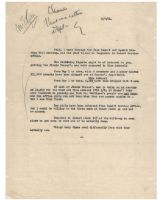 THOMAS A. EDISON (1847-1931)
|
| THOMAS A. EDISON (1847-1931) |
Inventor, businessman
Thomas Edison (1847-1931) was arguably one of the most influential people in all of history. Credited with "inventing" the Twentieth century and developing the modern research laboratory, he was the most prolific inventor in history with 1,093 U.S. patents in his name as well as patents in the United Kingdom, France and Germany. His numerous inventions included the electric light bulb, the phonograph and the motion picture camera.
Edison owned numerous companies including Thomas A. Edison, Inc, which oversaw his early recordings. The standard of the day was the phonograph and the phonographic wax cylinder. The cylinder was a tube containing up to 2 minutes recorded music. In 1912, Edison introduced the new Blue Amberol Cylinder. More durable than the previous design, these new cylinders could hold up to 4 minutes of recorded music. Edison's company would continue to sell cylinders until they went out of business in 1929.
This typewritten note, dated May 7, 1921, was composed by Charles Edison, son of Thomas Edison, to his father. It discusses the inefficiency of the Blue Amberol division of Edison's company. The content specifically compares employee Jimmie Carson and his team to the team working on Blue Amberol. Charles determines that the Blue Amberol division is not working to its full potential and suggests that the team manages to make itself look busy when necessary. Thomas Edison has written a personal note at the top, "Charles. This is a rotten dept." and includes his prominent initial, "E."
|
|
 |
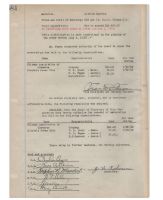 THOMAS A. EDISON
|
| THOMAS A. EDISON |
PART 2 OF MINUTES DOCUMENT
See Part 1 for description
|
|
 |
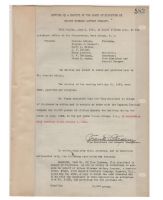 THOMAS A. EDISON (1847-1931)
|
| THOMAS A. EDISON (1847-1931) |
American inventor
American inventor whose inventions included the phonograph, the motion picture camera, the light bulb among many others. He is the fourth most prolific inventor in history with 1,093 U.S. patents in his name as well as patents in the United Kingdom, France and Germany.
Minutes of a Meeting of the Board of Directors of Edison Storage Battery Company," dated June 5, 1922. Presided over by Mr. Charles Edison, the board authorized the purchase of 16,000 pounds of lithium hydrate. Additional issues discussed were the annual renewal of memberships for in two organizations: Chicago Association of Commerce and the Electric Power Club.
The document was signed by the Board which included "Charles Edison," "Thos A Edison," "Stephen B. Membert," Harry "H.F. Miller," "J. V. Miller," "Henry Lanahan" and Secretary, "J. W. Robinson."
|
|
 |
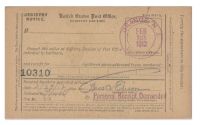 THOMAS A. EDISON (1847-1931)
|
| THOMAS A. EDISON (1847-1931) |
American inventor
American inventor whose inventions included the phonograph, the motion picture camera, the light bulb among many others. He is the fourth most prolific inventor in history with 1,093 U.S. patents in his name as well as patents in the United Kingdom, France and Germany.
United States Post Office receipt dated February 26, 1912 and first received by the Orange, New Jersey post office. Number 10310, the registry notice was presented to Edison on February 27, 2012. A great signature, the document is signed "Thos. A. Edison."
|
|
 |
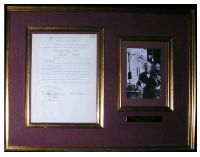 THOMAS A. EDISON (1847-1931)
|
| THOMAS A. EDISON (1847-1931) |
Inventor, businessman
American inventor whose inventions included the phonograph, the motion picture camera, the light bulb among many others. He is the fourth most prolific inventor in history with 1,093 U.S. patents in his name as well as patents in the United Kingdom, France and Germany.
This museum quality frame measures 24" x 19" houses two smaller frames. The left frame, measuring 8.5" x 12.25," features the typed "Minutes of a Meeting of the Board of Directors of Edison Storage Battery Company," dated February 1, 1921. Presided over by Mr. Charles Edison, the board allotted a portion of the meeting to discuss the "reduction in price of Caustic Soda from Mathieson Alkali Works, Inc." The document was signed by the Board which included "Charles Edison," "Thos A Edison," Harry F. Miller, John V. Miller and Secretary, "Arthur Mudd." The right frame, measuring 7" x 9.5," displays a photography of Thomas Edison.
|
|
 |
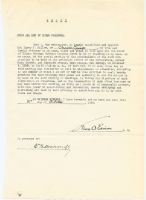 THOMAS A. EDISON (1847-1931)
|
| THOMAS A. EDISON (1847-1931) |
Inventor, businessman
Invented the phonograph, developed the electric light bulb and the motion picture projector. Typed document of the Edison Storage Battery Company concerning proxy voting. The proxy empowers Edison's son Charles to act on his father's behalf at the annual shareholders' meeting, the first such meeting after the great stock market crash a few weeks earlier. Boldly signed with an especially fine example of Edison's famous "umbrella" signature. Dated October 31, 1929
|
|
 |
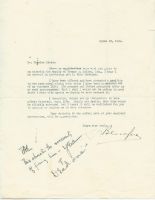 THOMAS A. EDISON (1847-1931)
|
| THOMAS A. EDISON (1847-1931) |
Inventor, businessman.
Invented the phonograph, developed the electric light bulb and the motion picture projector. Typed letter of resignation from an employee of Thomas A. Edison Inc., dated August 27, 1924, addressed to Charles Edison. Charles has commented and forwarded the letter to his father, writing "T.A.E., This obviates the necessity of firing him." Thomas Edison has added below, "Yes - Dead one. E." An intriguing glimpse inside Edison's pioneer research laboratory.
|
|
 |
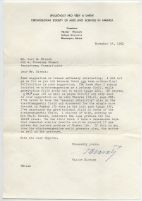 VACLAV HLAVATY (1894-1969)
|
| VACLAV HLAVATY (1894-1969) |
Brilliant Czech-American mathematician
He wrote extensively about Einstein's Theory of Relatively, and corresponded with Einstein on the subject for many years. Among his notable achievements were solving of several difficult and critical equations related to Einstein's Unified Field Theory. Typed letter on Hlavaty's stationery as president of the Czechoslovak Society of Arts and Sciences in America, dated November 14, 1961, concerning a detailed reply to certain questions relating to relativity, mathematics, and electromagnetic and gravitational fields. Signed by Hlavaty in blue ink.
|
|
 |
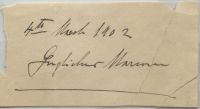 GUGLIELMO MARCONI (1874-1937)
|
| GUGLIELMO MARCONI (1874-1937) |
Italian Physicist and Inventor
Enormously important in the field of radio, he invented the wireless and formed the first radio communication company, "Marconi's Wireless Telegraph Company." Signature on paper dated March 4, 1902. Clean separation in paper at the "n" and "i" in his last name. A nice strong, early Marconi autograph.
|
|
 |
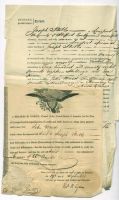 FRANCIS BARBER OGDEN (1783-1857)
|
| FRANCIS BARBER OGDEN (1783-1857) |
American inventor, Aide-de-Camp to Andrew Jackson at the Battle of New Orleans.
He was a pioneer in the field of nautical steam engines - in 1837 the first boat powered by a screw propeller was named in his honor. Partially printed consular document concerning a shipload of goods bound for Philadelphia from Liverpool, where Ogden was US Consul. Dated September 19, 1834, and signed "Fras B. Ogden."
|
|
 |
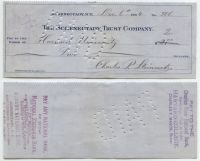 CHARLES P. STEINMETZ (1865-1923)
|
| CHARLES P. STEINMETZ (1865-1923) |
Renowned mathematician, electrical engineer and inventor
Noted for his pioneering work in artificial lightning, and in alternating current electricity. Check drawn on the Schenectady Trust Company of New York for $2.00, payable to Harvard University. Dated December 6, 1904, and elegantly signed "Charles P. Steinmetz."
|
|
 |
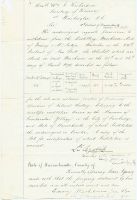 LOUIS AGASSIZ (1807-1873)
|
| LOUIS AGASSIZ (1807-1873) |
Swiss-born scientist, respected for his work in natural history. Member of the French Academy of Sciences, the Royal Society, and virtually every other European and American scientific organization. Manuscript document requesting the release from a warehouse of a quantity of alcohol "for the sole and exclusive purpose of preserving specimens of natural history." Addressed to the US Secretary of the Treasury, dated April 5, 1873, and signed by Agassiz as Director of the Museum of Comparative Zoology.
$135.00 |
|
 |
|
|

